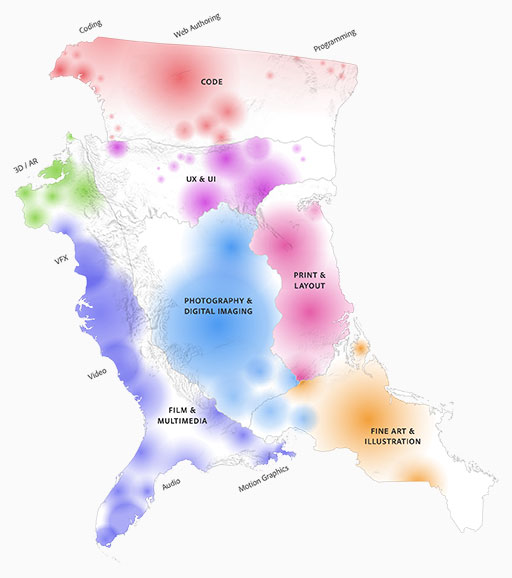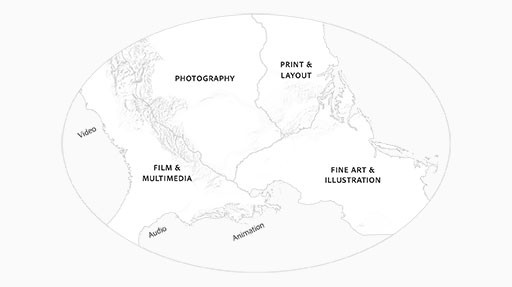3. Machine intelligence Unifies creative mediums
Today’s creative landscape is siloed across creative disciplines and domains, isolating our tools and causing cross-domain friction. But machine intelligence can provide domain agnostic access to our content, allowing for new movements across the creative landscape, and the possibility of new creative verbs for us to engage.
Appreciating maps as art and product
Maps are peerless informational tools. They offer us multi-dimensional views of the spaces we occupy and navigate. Their language is visual and purposeful, and their form is flexible and extensible. They simultaneously serve us details about the macro and the micro, and audiences can experience them universally across countries and cultures. They also support the rare ability to exist as both art and as product.
It’s easy to recognize and celebrate a map’s artistry: displayed in a frame, in a coffee-table book, or as graphical pattern on an everyday thing. But to focus on the product design of a map reveals an equally exciting set of displays to admire:
- A display of present state: Defines a landscape as it exists today, and facilitates our navigation and orientation of that space. Additional overlays can also provide details relevant to exact regions and locations.
- A display of past states: Shows a landscape as it once existed, at either single or multiple points in time. These views can be especially valuable when used as comparison or storytelling devices.
- A display of possible futures: Visualizes a future landscape that could exist, modeled on projected estimates, or imagined through “what if” scenarios.
But how is this relevant to machine intelligence and the next creative wave?
Where the concept of the “language gap” promotes characteristics of machine intelligence relevant to creative tools, our understanding of those tools is limited if they’re kept isolated from the wider creative landscape that they operate within. As well as increasing our understanding of tools, an exercise in surveying this landscape can also reveal factors that inform how machine intelligence might exist upon it.
In order to outline the creative landscape in this way, we’re prompted to imagine a map.
A creative landscape map: Present realities
Using the “Timeline of digital creative tools, 1985–2020” as reference, an illustrative map of the present-day creative landscape is shown below. This map holds a total of six creative domains, with a number of sub-domains also labeled for further clarity. Like an aerial photograph of a city at night, different color highlights broadly heat-map the presence of a creative population, who are clustered around the digital tools, materials, and disciplines that they associate with.

Assessing the geography and make-up of each of these regions hints at certain creative realities:
- Creative domains are siloed, with many tools and materials contained within their borders. It’s therefore common for creatives to specialize, working exclusively under the banner of a single tool or discipline.
- A creative’s ability to move across domains is limited. Domain switches are typically met with learning curves and incompatible file formats. Successful travel with a creative asset from one tool to another is often a multi-step journey that doesn’t allow for a return trip.
- Inter-operability is never assumed when tools are created by different developers, even within the same domain. Some tool developers support easier travel across domains via their products, but not without some friction caused by the domain itself.
- To avoid complex movements across the landscape, creatives will sometimes go as far as building workarounds to emulate a different domain within their existing tool. For example, using a screen design and prototyping tool for print and layout work.
A creative landscape map: Silos in the past
The realities of this present-day creative landscape prompts further questions. In particular, have these siloed conditions always existed? Below is a past view of the creative landscape, this time referencing the period before the “Timeline of digital creative tools, 1985–2020”.

Here, the full extent of the present-day landscape has yet to be uncovered, resulting in a minimized view that focuses entirely on analogue domains. The lack of digital tools causes no color to be present on the map. There are also subtle but noteworthy differences in map labels: the Photography domain doesn’t include Digital Imaging; and the Animation sub-region—bridging the space between Illustration and Film—will soon migrate to the sub-region of Visual Effects and CGI, leaving a space that will evolve into Motion Graphics.
When considering the existence of creative silos, this landscape offers some viewpoints:
- Domains are seemingly formed around creative materials, and become established once tools mature and are adopted at scale. A maker’s skill in manipulating a given material with their tools comes from investing time to experience its properties and behaviors. For example, a watercolor artist’s understanding of how water and pigment are most effectively applied to paper with a brush.
- The physicality of this analogue environment also creates a further barrier-to-entry alongside the language of tools: the cost of physical space. For example, a Photographer requiring access to a dark room, or a sculptor needing a studio to store materials and output.
- Interestingly, physicality also allows for an increase in cross-domain movements. But this doesn’t mean that creative materials are more compatible in the analogue realm. Creatives can fall victim to moments where their materials refuse to work together, or where a tool is simply ineffective—even destructive. Any changes made to work are permanent, and the levels of domain fluency required to perfect a particular discipline are only heightened when the undo button doesn’t exist.
This past landscape suggests that creative tools maintain an intrinsic link with the materials they were created to work with. As a result, domain silos can be seen as an embedded byproduct of a tool’s DNA. In light of the the fact creative applications emulate many of our physical materials and tools on-screen (often in proprietary ways), it becomes easy to play out this narrative of silos into the present-day, and even see it reflected in our new digital materials such as code and pixels.
A creative landscape map: Future transformation with machine intelligence
But what of the future landscape? Depicting it can quickly stumble into cartoon make-believe and vague fiction if mishandled. Thankfully, our visuals of the past and present landscape help to mitigate this by defining a context to remain consistent with. This approach will consider the impact of machine intelligence on that landscape, applying a perspective that’s conscious of what’s come before.

In this visual, the nature of machine intelligence—how it supports the narrowing of the language gap between creative tools and creative intent—profoundly impacts the future creative landscape in a number of ways:
- Machine intelligence’s ability to recognize the subject matter of our content helps to significantly increase file format compatibility. In the future, creative tools will more readily analyze, open, and edit assets, regardless of their origins.
- Expanded asset compatibility empowers creatives to not specialize so exclusively to a particular tool or discipline. Future creatives will move their assets more seamlessly across mediums—from a voice description, to a sketch, to a vector graphic, to an animation, a 3D video, to a print asset, and so on—all in support of moving their ideas more fluidly.
- More creatives engaging in cross-domain activities leads to an increased level of collaboration. Less time will be spent organizing, naming, and formatting assets for team hand-off—in-part thanks to machine intelligence’s ability to auto-organize on-behalf of users—and instead, creatives will engage in the real-time co-creation of work together.
- Machine intelligence will play a significant role in reducing barriers-to-entry across creative tools and disciplines. Over time, democratization will also open the possibility of domains moving and merging across the landscape, eventually leading to its complete reconfiguration.
- These reconfigured spaces won’t be anchored to a specific tool or file type. Instead, they’ll offer open environments rooted in the creative verbs that help cultivate and develop our ideas; We’ll pursue research, iterative experimentation, rapid prototyping, and methods that echo the components of design thinking and design strategy.
A future creatives want?
This imagined future landscape posits (optimistically) that machine intelligence will help unify creative mediums. From the vantage point of a zoomed-out, map-based overview, the narrative is at least compelling. But does it accurately reflect what the population of this creative landscape truly wants? Maybe creatives are content with the current domains and specialized tools available to them today? Or, are they, in fact, actively trying to navigate creative processes that cross multiple domains, are collaborative, iterative, and engaging new ways of working through their ideas?
Writing for the Smithsonian on the subject of maps, cultural historian Jerry Brotton reflects: “… Ever since [we] first learned how to make graphic marks on rock… people have created maps as a way of conceptualizing themselves in relation to their environment… Maps are as much about existence as they are about orientation”.1 Brotton’s words emphasize maps as much more than a visual document of a given space, regarding them also as records of culture. Indeed, much of this essay considers the implications of machine intelligence at a level of creative culture. But how can we see that detail more clearly?
Amazingly, maps support our ability to render these cultural details, thanks to an essential element of its product design—its user experience. The viewing experience of maps is one that lets users encounter consistent and intuitive movements of panning, zooming, and observing. To more effectively see the culture and movements of a creative population walking towards the next creative wave, we can zoom in…
Further thinking
Ask yourself or discuss with others
- Thinking about the creative domain you most associate with, where would you place yourself on the present-day creative landscape illustrated in Figure 1? (More than one location is fine.)
- Is there a creative discipline you’ve always wanted to try and use in your work, but not knowing the tools has stopped you from doing so?
- These maps are only illustrative. Based on your own personal experiences, how might you draw the present landscape differently? What would you add, remove, reduce, expand, or move?
- Think about a project you worked on recently. Looking at the map of the future creative landscape [Figure 3], is it possible to draw the journey of your project across it? (Remember that the regions aren’t as discipline specific)
References
- Brotton, Jerry. Great Maps: The World's Masterpieces Explored and Explained, Dorling Kindersley, 2015, p. 7